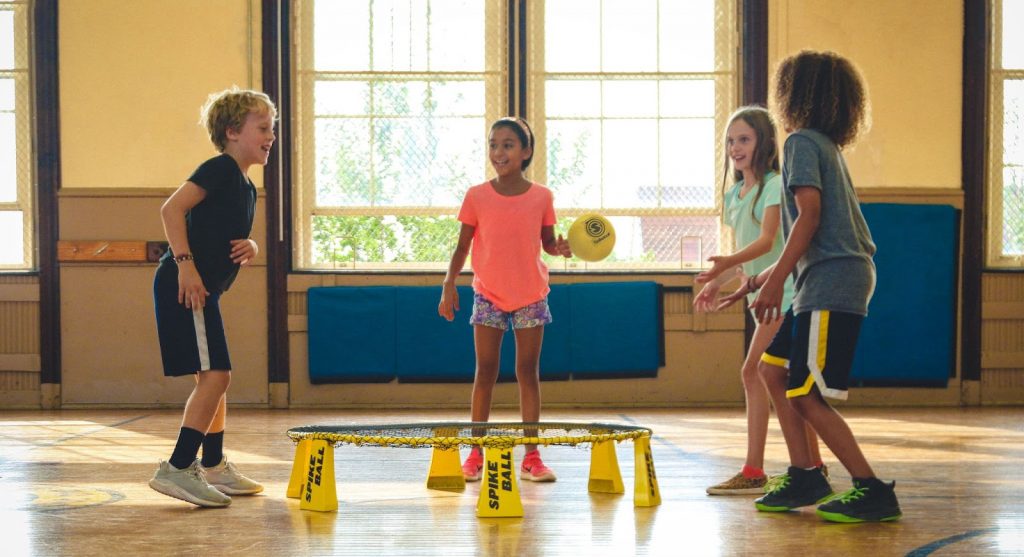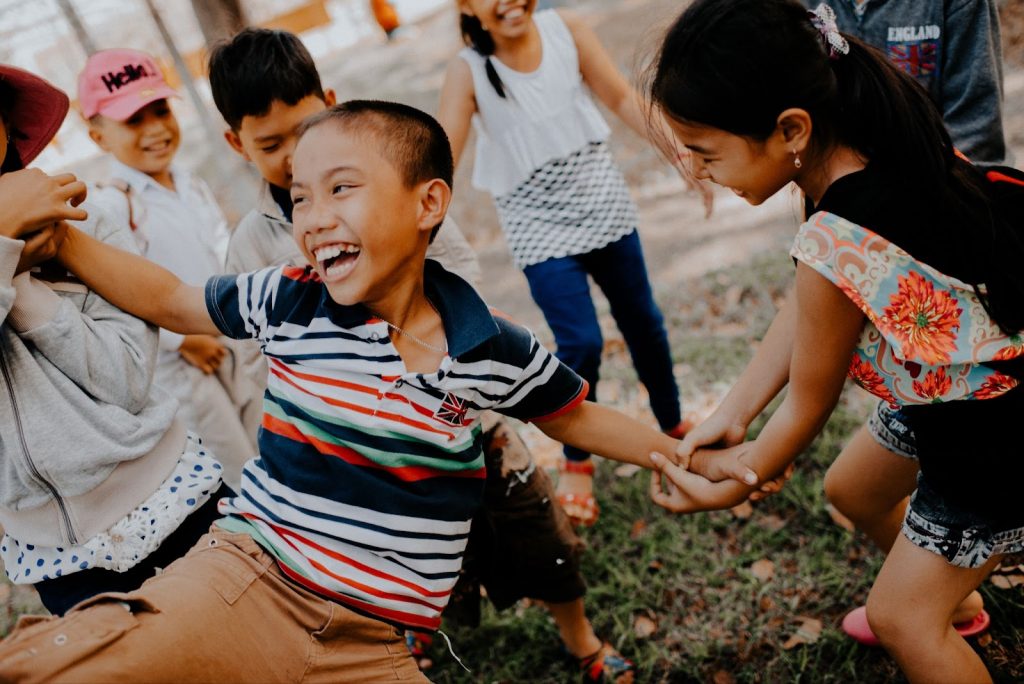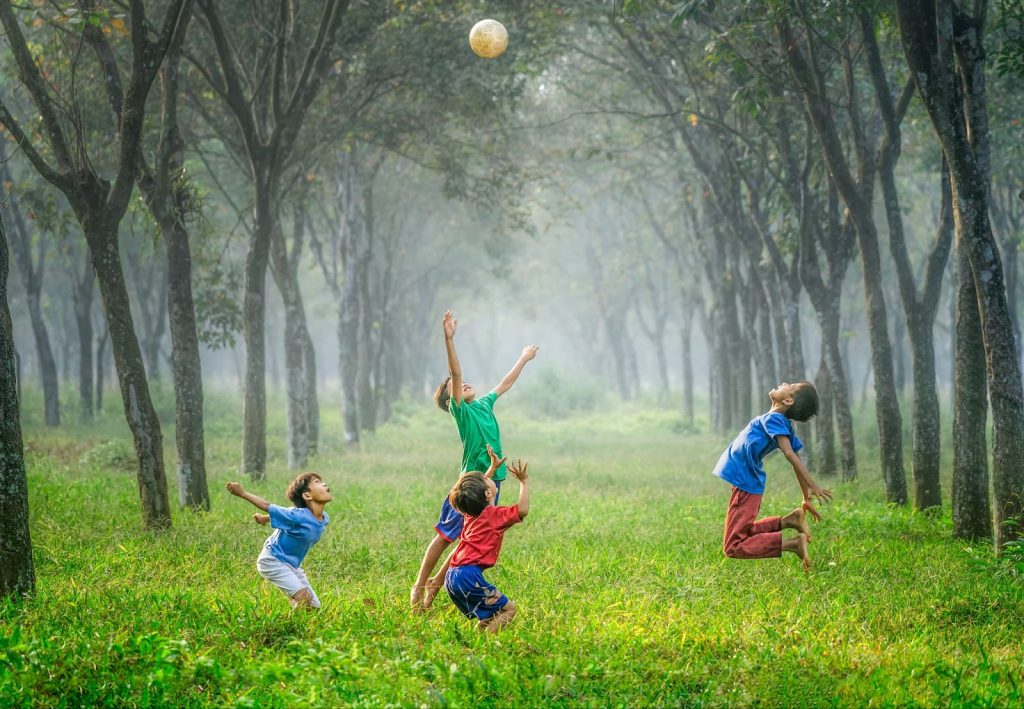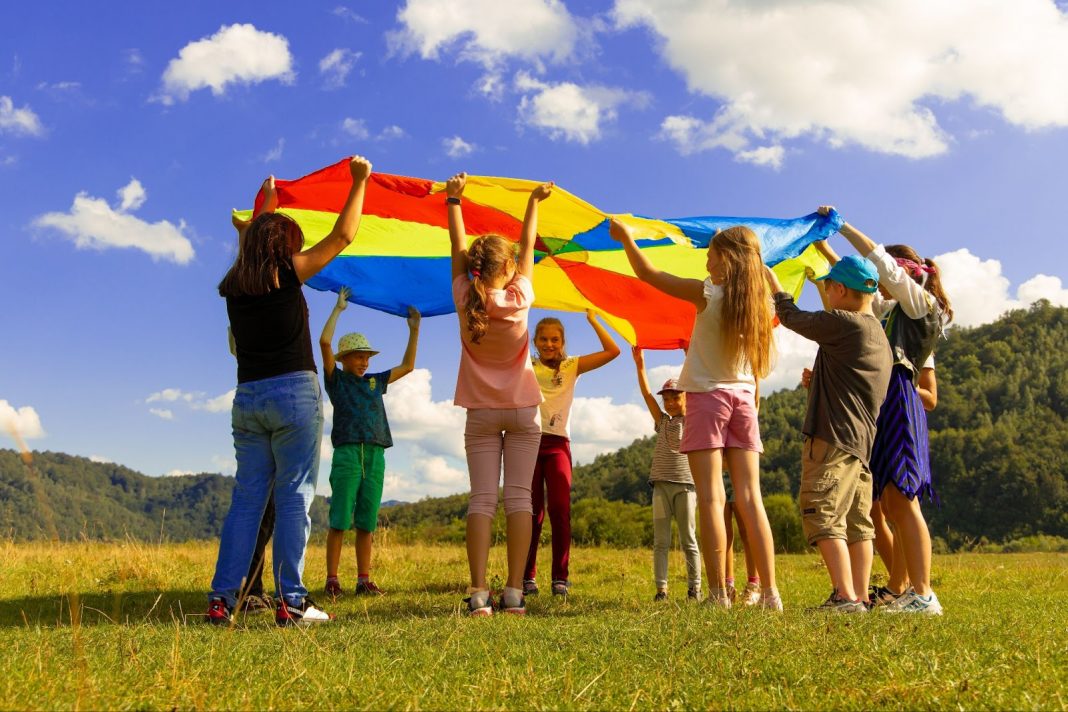Group games are among the best ways to engage kids and keep them entertained. Group games for kids are not just a fun way to spend time with them but also contribute to building communication and social skills in them. So if you’re looking for the absolute best games to play with a group of kids or your students, we have just the right list of fun group games for kids: both indoor and outdoor!
Math & ELA | PreK To Grade 5
Kids see fun.
You see real learning outcomes.
Watch your kids fall in love with math & reading through our scientifically designed curriculum.
Parents, try for free Teachers, use for free
Looking for more online Math games and ELA games to educate and engage your kids? Here are more games to check out!
Related Reading: Best Concentration Games for Kids to Develop Super Focus & Attention Skills
Exciting Indoor Group Games for Kids

Indoor group games are perfect for days when it is raining outside, or it is too cold to step out to go to the playground. Make the most of your classroom or an indoor court with some fun group games.
1. Steal The Bacon
Age Range: 8–12 years
Number of Players: 10–20
Things You Need: Random objects like toys, a ball, a towel, etc.
How to Play:
- Divide the group of kids equally into two teams and make them stand in two lines facing each other. The lines should have some distance in the middle to play.
- Assign numbers to each team member and make the matching numbers stand before each other.
- Place any object (a towel, a pencil, a ball, shoes, or a toy) between the two teams and shout a random number.
- The members assigned the number will have to compete with each other to grab the item and run back to their teams. Whoever does it first gets the point. The team with the highest score wins in the end.
2. The Taboo Word Game
Age Range: 10–12 years
Number of Players: 10–12
Things You Need: A timer and a list of topics
How to Play:
- Divide the kids into equal teams of three or four and make them sit separately in groups facing you.
- Give them taboo words or filler words that we use when we speak, like “ah,” “umm,” “like,” “so,” etc. These are the words that have to be avoided by both teams.
- Give them a list of simple topics to speak on, like “My Favorite Color,” “My Favorite Sport,” etc.
- Ask the teams to choose a member to speak on one of the topics provided for one minute without using taboo words.
- If a kid successfully completes this round, they will move on to the next round, and the team that has the least amount of taboo words used will win.
3. Fruit Basket
Age Range: 8–12 years
Number of Players: 12–16
Things You Need: paper, pen, double-sided tape
How to Play:
- Divide the kids into four equal groups and ask them to decide on a category (colors, fruits, animals, etc.)
- Hand each student a sheet of paper and ask them to write their favorite from their chosen category. Each team has to ensure that everyone has a unique word on their sheet of paper.
- Now mix up all the groups and form a circle. Each kid must stand on top of their sheet of paper.
- One kid will stand in the middle of the circle (without a sheet under their feet) and announce the category name of a group. All the members of this group must now run and change places with each other while the kid in the middle also tries to steal a spot.
4. Awesome Architects
Age Range: 8–12 years
Number of Players: 6–12
Things You Need: Glue, tape, newspapers, clips, and other arts and crafts materials of your choice
How to Play:
- Divide the kids into equal groups and provide them with the same materials.
- Instruct them to create a thing of the utility of their choice (like a photo frame, pen stand, paper weight, newspaper bridge, etc.) and establish the rules.
- Set a time limit or award the fastest team to be the winner.
5. Five Minute Theatre
Age Range: 10–12 years
Number of Players: 12–15
Things You Need: Theater props
How to Play:
- Divide kids into groups of three and give them 15 minutes to prepare a skit of 3–5 minutes to perform.
- The other teams are allowed to help them with props while they perform.
- The best performance wins the game.
6. Bob The Weasel
Age Range: 7–12 years
Number of Players: 10–15
Things You Need: A small discreet object
How to Play:
- Make the kids sit down in a circle and choose one kid to sit in the middle. The kid that sits in the middle is “Bob the Weasel.”
- The kids in the circle now have to put their hands behind themselves and pass the hidden objects to each other without Bob noticing.
- If Bob catches a kid passing the object, this kid becomes Bob, sits in the middle and the game continues.
7. Walrus
Age Range: 8–14 years
Number of Players: 10–12
Things You Need: Chairs and space
How to Play:
- One kid is “it” and is sent out of the room. The rest of the group sits in the room together and decides on activities like sleeping, eating, running, studying, etc.
- Once this activity is chosen, they pick a random word to replace the action. This can be anything: flower, dolphin, apple, etc.
- The person outside the room now enters and now has to guess the activity by asking questions of everyone. The group will replace the activity with the chosen random word and answer.
For example, if the chosen activity is eating and the chosen random word is “dolphin,” the answer to the question “Where do you do this activity?” is “I dolphin at school, home, and sometimes, outside.”
8. Look Up, Look Down
Age Range: 8–14 years
Number of Players: 15–20
Things You Need: Some space
How to Play:
- The kids form a circle and stand a few feet apart from each other.
- The game’s moderator says, “Look down,” and everyone looks down. When the moderator says, “Look Up,” all kids have to look at any one of the other kids.
- The kids looking at each other will leave the circle, and the game will continue until only 2–3 players are left.
Related Reading: Best Classroom Games to Help Teachers Elevate Their Efforts
Super Fun Outdoor Group Games for Kids

There’s nothing better than the sun, some dirt, and a few lessons on group building and socializing on a warm, breezy day. Teach your kids or students some valuable lessons on social skills with these amazing outdoor group games:
9. Spell It Out
Age Range: 8–12 years
Number of Players: 10–12
Things You Need: Paper and pen
How to Play:
- Make a list of four-letter words on paper.
- Divide kids into equal groups and say the words one by one aloud.
- The teams must spell each word using body poses, fingers, and actions. The team that gets the most number of correct spellings wins the game.
10. All Over
Age Range: 8–12 years
Number of Players: 10–16
Things You Need: Softballs, space
How to Play:
- Divide the kids into two equal teams and give them two equal territories of space and an equal number of balls.
- The teams now have to throw the balls in the other team’s territory, and once their balls are all over, they shout “All Over” and win the game.
- If there are too many balls, you can also set a timer and declare the team that has the least amount of balls in their territory the winner.
11. Elves, Wizards, and Giants
Age Range: 8–14 years
Number of Players: 10–15
Things You Need: Space
How to Play:
- First, understand that this game is like rock, paper, scissors. Elves can beat giants. Giants can beat wizards. And wizards can beat elves. The kids that are elves have to put their index finger along their ear and extend it a little. Giants have to have their hands raised. And wizards have to make a triangle with their raised hands.
- Divide the kids into two equal teams and give them two equal territories in the playground. The teams have to be a few feet away from each other. Both the territories will also have a designated safe space for the teams.
- Both teams get a couple of minutes to decide if they want to be wizards, giants, or elves. When the moderator says go, both teams scream what they’ve decided to be, and the stronger one chases the other team.
- The team that is being chased can also stand in their safe space. The one that is caught is tagged and becomes a part of the other team now.
12. Dragon’s Tail
Age Range: 8–12 years
Number of Players: 12–18
Things You Need: Open space
How to Play:
- Ask the kids to form a chain holding hands. The first kid on the chain is the head of the dragon, and the last one is the tail.
- The head of the dragon has to catch the tail of the dragon. And the rest of the kids in the chain must try to prevent him from doing that.
- If the head catches the tail, the kid on the tail becomes the head, and the head becomes the tail, and the game continues.
13. You’re It
Age Range: 8–12 years
Number of Players: 8–12
Things You Need: Open space
How to Play:
- Decide on a person who is “it” from the group and ask them to go behind a tree or a wall and count to a hundred.
- The rest of the group has to go and hide in different places before the chosen kid returns.
- The kid who is “it” now comes back and tries to spot the rest of the group. Once they spot someone, they have to run and catch someone.
- The one who is caught now becomes “it” and the game continues.
14. Tug Of War
Age Range: 8–15 years
Number of Players: 10+
Things You Need: Open space, a rope
How to Play:
- Divide the group into two equal teams and mark their territory.
- Hand them a rope and tie a hanky right in the middle of it.
- Instruct both teams to pull the rope toward them using all their strength. The team that pulls the rope toward them entirely wins.
15. Balloon Battle
Age Range: 8–12 years
Number of Players: 12–18
Things You Need: Open space, balloons, thread
How to Play:
- Divide the group into two equal teams. Give each team balloons of separate colors and instruct them to tie one balloon each on each player’s ankle.
- Each player has to attempt to stomp the balloons of the other team players while also saving their own balloon.
- The team that stomps all the balloons of the other team first wins.
16. What’s the Time Mr Wolf?
Age Range: 8–12 years
Number of Players: 12–18
Things You Need: Open space
How to Play:
- Choose a player to be Mr. Wolf and make them stand a few feet away from the rest of the group.
- The rest of the group will stand in a territory and start the game by asking, “What’s the time, Mr. Wolf?”
- The player, Mr. Wolf, will respond by saying, “It’s 3 o’clock” (as an example). The group then has to take three steps toward Mr. Wolf. Every time Mr. Wolf tells a time, the team takes the same amount of steps toward the player.
- The player who tags Mr. Wolf first wins. The catch though is that Mr. Wolf, at any time, instead of telling the time, can say “It’s dinner time.” This is when Mr. Wolf will try to catch anyone from the group before they all run back to their territory. The players can either take smaller steps to stay safe near their territory or take bigger steps to tag Mr. Wolf faster and take risks.
Top 5 Benefits of Group Games for Kids

Children’s brains are always developing and adapting. Exposing them to real interactions outside of their homes and classrooms is very important to enable them to learn how to socialize and navigate the world. Even when they’re learning in a classroom, their interaction is limited since the focus stays on reading, writing, and speaking. Group games also help kids gain confidence, improve self-esteem, and increase focus. Here are some advantages of group games for kids:
1. Team Work
This is one of the most important skills kids will use in adulthood. According to a study on how cooperative learning affects group work of children in Grade 1 of primary education, cooperative learning leads to improved group work behavior in children. Interacting with their peers in a team gives them a sense of team building and belongingness.
2. Motor Skills
Group games that require kids to run around and challenge them physically keep them active. These games help them redirect their energies into something productive and fun and lay a foundation for an active lifestyle in their adult life.
3. Social Skills
Group games enable kids to interact and connect with others. A study conducted to analyze how playing group games affects cooperation skills found that group games promoted cooperation skills. It also enabled kids to learn better than in a classroom.
4. Increased Confidence
Group games enable children to socialize and navigate in social situations better. The more they get to participate in groups, the more confident they get in socializing and teamwork. Kids group games also enable children to gain a sense of pride and achievement when they win a game along with their team, thus boosting their confidence.
5. Better Self-Esteem
According to Cambridge English, playing games helps children to participate, engage, get a sense of achievement, and recall their learning better than in a classroom setting. This helps to make them more confident and build their self-esteem.
Frequently Asked Questions (FAQs)
Which game is the best for a group of kids?
Depending on where you are, how many kids are in the group and their age group, and your materials, you can choose to play games like Awesome Architects, Hide and Seek, You’re It, and Red Light Green Light.
What games to play with a group of five-year-old kids?
Some great games you can play with a group of five-year-olds are Cat & Mouse, Duck Duck Goose, Look Up Look Down, and Blind Man’s Buff.
What do you play with a large group of kids?
Games like Charades, Bite The Bag, Back Up, Cherry Bag, and Back Draw are great to keep a huge group of kids entertained for a long time.
























